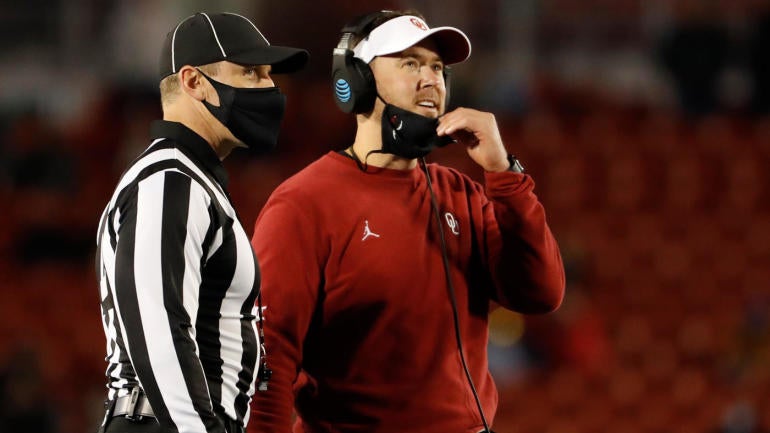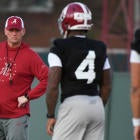
When Oklahoma transfer Chandler Morris scrimmaged this weekend with TCU he still had not yet been released from his scholarship at OU. Half Horned Frog, half Sooner? Well, yes, that's entirely possible in the current wacky transfer environment.
You may not know Chandler Morris from Chandler Bing. The rising sophomore quarterback from Dallas Metroplex power Highland Park threw only five passes as a freshman playing behind Spencer Rattler.
All the way back in January, Morris had tweeted out his transfer decision. One problem: Exercising an intraconference rule that is completely his right, Oklahoma coach Lincoln Riley recently said he would not allow Morris to immediately transfer.
"We think it's unhealthy for college football to encourage intraconference transfers," Riley said.
Predictably, a Twitter hashtag sprung up: #FreeCM4.
While Morris continues to practice, he cannot actually play for TCU this fall unless he is released by Riley. That means, for the moment, Morris would have to sit out 2021 per Big 12 intraconference transfer rules and lose a year of eligibility. Normally, such a situation would be one of those in-league snits that periodically light up a sleepy offseason.
This one may be the last of its kind.
Take a good look, college football. This sort of obstruction is about to go away.
Everywhere.
Soon.
The ACC sent a stark message March 15 when it eliminated its transfer rule. Every conference has a similar directive. It exists outside NCAA legislation and is meant to be restrictive. In a way, it's also understandable. No coach wants to be beaten within his own conference by a player he recruited and developed. But times are changing before our eyes.
A league source tells CBS Sports that the Big 12 working group is "heavily leaning" toward doing away with the rule Riley is using to block Morris, the son of veteran offensive coordinator Chad Morris.
Separately, a one-time transfer exemption is expected to be approved by the NCAA next month, at the latest. That legislation, which would allow all athletes in so-called "revenue sports" to transfer once in their college careers without sitting out a year-in-residence, is expected to further wear down conference strictures.
"There's no ground to stand on anymore," said a Power Five administrator referring to coaches or conferences restricting player movement.
The ACC bravely took the first step. It will not be the last. That rule change was both a message to conferences that have unfairly denied athletes their liberties and a look into the future of college sports.
"It's freedom of movement," ACC commissioner Jim Phillips told CBS Sports. "That's a fundamental part of our country. We have professors and presidents and athletic directors, conference commissioners who move from one school to another.
"The direction we've been heading relative to the student-athlete experience in the last decade or so and the last four or five years in a more intense way. It's just the appropriate decision to make as a conference."
The move was credited to the ACC Board of Directors (school presidents). It had the signature of Phillips, one of the most forward-thinking college administrators. This is what a commissioner does -- leads substantive change.
Since at least 1964, the NCAA has forced transfers in revenue sports to sit for that aforementioned year in residence. The logic was never logical. Proponents pointed to a higher graduation rate for those who sat out. But what about the lower graduation rates of those in "non-revenue sports" like volleyball, wrestling, soccer, etc. who didn't have to sit out?
Further clouding the matter is that the year in residence restriction was only applied to athletes in five sports: football, men's and women's basketball, baseball and hockey. That's five out of the 24 sports sponsored by the NCAA. The academic argument is unfair at best, hypocrisy at worst.
Just like legal, philosophical and ethical momentum has pushed the NCAA to embrace name, image and likeness legislation, the conferences will have to change on intraconference restrictions. It's taken a while, but thank goodness college athletics continues to be caught up in a tidal wave of doing the right thing.
"I think it will put pressure on most conferences to make the change, but I won't be surprised if some resist," said Tim Nevius, a prominent New York-based attorney advocating for athletes' rights. "It will become one more factor for athletes to consider in recruiting."
Sure, there will be resistance. Try ramming intraconference freedom past the SEC anytime soon. But eventually, the Strength Everywhere Conference will fall, too. This is the last stand for paranoid coaches who fear a transfer sharing the playbook with a conference rival.
Even if that happens, tough spit. The NCAA demands athletes have as similar an experience as possible compared to regular students. Coaches worry about roster management. One of those concepts don't seem as important as the other.
It will take only another Power Five conference or two to follow the ACC and force everyone's hand. The Big 12 intraconference rule is already written in such a way that NCAA legislation (such as removing the one-time transfer restriction) will for the most part override the league's intraconference rule.
You can see the future from here: If the Big 12 flips, the SEC, Pac-12 and Big Ten look more like outliers. Instead of griping, as Nevius suggested, coaches in the ACC and Big 12 could use the new freedom as a recruiting pitch.
Imagine Tom Brady back in the day being able to transfer to Ohio State to get more playing time. Riley himself eventually relented and allowed quarterback Austin Kendall to transfer to West Virginia in 2019.
One Pac-12 source mentioned that coaches in that league are tired of losing basketball talent to the mid-majors the Big Sky and West Coast Conference because those players were restricted from moving inside the Pac-12.
"I'd rather those kids stay in the Pac-12," the league administrator said. "They're all good players. We're seeing first-hand how important basketball is to the league. We're experiencing the joy of positive basketball. I'd rather see a kid [stay within the Pac-12] than go to Montana and dominate the Big Sky."
There's also this: As much as your favorite team could be gutted by a conference rival, it could also do some gutting.
If coaches' only argument is the unfairness of it all, get in line. Life is unfair. Most of us don't get to cash million-dollar paychecks to mitigate that inequity.
In their heart of hearts, coaches have to know their intraconference rule is over.
Riley has made a living with transfers. The OU coach has landed three four-star Tennessee transfers from the portal in 2021 alone. He has specifically hit home runs with transfer quarterbacks, one of them from a Big 12 rival. In 2016, at the Big 12 spring meetings, the conference changed its rules to accommodate Baker Mayfield.
That was a year before Riley took over for Bob Stoops. Try to envision Riley's first season in 2017 without Mayfield, who gained that extra year of eligibility thanks to the Big 12 after transferring from Texas Tech.
Those five revenue sports continue to deal with players' new-found freedom. At last check, the transfer portal has more than 1,000 players in it. Resisting that freedom is futile. The game has long been weighted toward coaches. Now, it's the athletes' turn.
As far as whether Riley changes his mind on Morris? It's going to fascinating, bewildering, inspiring and possibly inevitable.





















